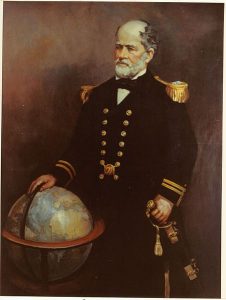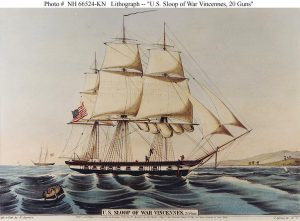By Robert Hodge
This article was first printed in the May 1978 issue of the Fredericksburg Times magazine and appears here with the author's permission.
This American who is truly deserving of the terms "great" and "famous" was born January 14, 1806, in Spotsylvania County. He was the seventh child of Richard and Diana Minor Maury.
In the fall of 1810, the family moved to Tennessee where young Maury grew up and received a good education.
Influenced by the accounts of his oldest brother's experiences as a Navy man, Matthew Fontaine Maury joined the Navy in 1825.
His first tour of duty was aboard the USS Brandywine when she carried the Marquis de Lafayette back to France after his visit to the United States.
On his second tour, he was transferred to the USS Vincennes, which was the first U.S. Navy vessel to have completed a trip around the world when it sailed into New York harbor in 1830.
Given three months' leave after his five years at sea, Matthew went back to Tennessee for a brief visit with his parents. Returning to the East and his naval profession, he began recording information on the ocean currents and the winds. This information was the basis for many publications by Maury, and these were to earn him the title "Pathfinder of the Seas." He also courted Ann "Nannie" Hull Herndon, whom he married July 15, 1834.
Lacking further orders for major voyages with the Navy, which had more sailors than ships, he occupied his time with other jobs: operating a gold mine, working survey parties, preparing other publications, and looking after his aging parents in Tennessee.
In the fall of 1839, while returning to Virginia from looking after his parents, the stagecoach on which he was a passenger overturned, and Maury suffered a badly broken leg. It did not heal properly, and he remained lame for the rest of his life.
In 1842, he was appointed Superintendent of the Depot of Charts and Instruments in Washington, D.C. There he was able to analyze past records of sailing lanes and conditions of the oceans and weather. He was also able to request ships to provide more information. From all this information he was able to prepare the useful Pilot's Charts used by all ships. From that day to this, every chart has a note in the margin that Maury was responsible for them being made.
The Depot of Charts and Instruments was changed over to become the U.S. Naval Observatory, and in 1844 Matthew Fontaine Maury was its first superintendent.
Interested in quality education for Navy men, Maury constantly talked about the need for a naval school and it was largely through his efforts that the U.S. Naval Academy at Annapolis was established in 1845.
In the 1850s, Maury was urging exploration of the uncharted waters of the world. He provided much encouragement for the polar basin explorations of Elisha Kent Kane. He also arranged for his brother-in-law, William Lewis Herndon, to explore the Amazon River from its headwaters in the Andes to its mouth.
It was Maury who proposed a world conference for developing a universal system of weather observations. When the conference was held in Brussels in 1853, he was the speaker who made the opening address.
Records collected by Maury on the nature of the bottom of the ocean allowed Cyrus Field to lay the first transatlantic telegraph cable, which was first operated in 1858.
In 1855, the Navy was overstaffed, so a Navy examining board was created and told to "retire" all men who were not able to perform all the duties expected of a Navy man. That board declared Matthew Fontaine Maury as "unfit" for service because of his lameness. While he was retired from the Navy, he was allowed to continue at the Observatory. Maury was angered at the action and remained so even though Congress overturned the Board's ruling in 1858, and restored him to the active list with a promotion to Commander.
As time passed, he was fully aware of the political differences developing between the North and South. Two days after Virginia seceded from the Union, Maury, because of his Virginia birth and Southern upbringing, resigned from the Observatory and from the Navy and immediately offered his services to the Confederate government.
During the war, he made improvements in underwater mines (called torpedoes at the time) and was the first American to successfully explode one by the use of electricity.
In 1862, the Confederate government sent Maury to England to purchase and equip for war one or more ships and to try to get foreign countries to work with the South. In 1865, as Maury was set to return to America, the war ended and the amnesty (pardon) that was given to most Confederates was not given to people who had been as active as Maury. Had he come home he would have been arrested as a traitor by the United States. Having met and been greatly liked by Maximilian, the Emperor of Mexico since 1864, Maury went to Mexico. He devised a plan to start a "New Virginia Colony" which was to encourage immigration into Mexico, especially of those Confederate soldiers who did not wish to stay in the United States. Maximilian put Maury in charge of the program. After a short time, Maury took a trip to England to see his family, and while he was gone, the Mexican government overthrew the Emperor and did away with the "New Virginia Colony."
In 1868, Maury, who had been offered a professorship at several Southern schools, decided to accept the offer of the Virginia Military Institute, though he was still fearful of what the U.S. government might do when he returned. Fortunately, while he was on board ship returning to the U.S., President Johnson issued the Amnesty Proclamation that made it safe for him to return.
Matthew Fontaine Maury was a professor at V.M.I. from September 1868 until his death in February 1873.
Editor's note: Matthew Fontaine Maury is buried in Hollywood Cemetery in Richmond, Virginia.
Web Links of Interest:
Matthew Fontaine Maury: Benefactor of Mankind by Captain Miles P. DuVal, Jr. USN (Ret.)
Matthew Fontaine Maury Papers at Virginia Military Institute
In the Library
Matthew Fontaine Maury, Father of Oceanography
Several biographies of Matthew Fontaine Maury are also available to read in the Virginiana Room of the Central Rappahannock Regional Library.
CRRL card holders may also find additional biographical resources through our biographical and historical databases.



